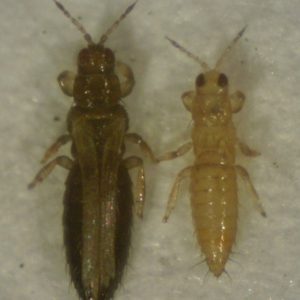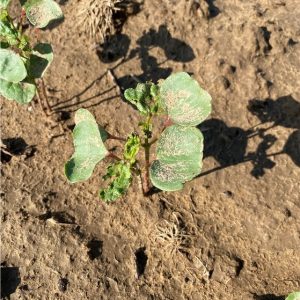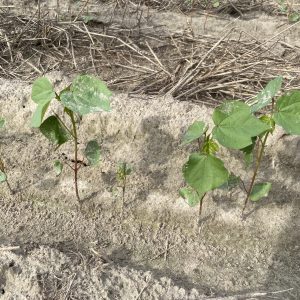Crop Production

The new cotton expressing the Bacillus thuringiensis (Bt) toxin Cry51Aa2, commercially trademarked as ThryvOn and developed by Bayer Crop Science, will be available in the 2023 growing season. ThryvOn is unique from other current Bt toxins used to target caterpillar pests in cotton. This new toxin has activity against several key insect pest species of cotton in the southeast, with the most important being tobacco thrips (Frankliniella fusca) (figure 1); western flower thrips (Frankliniella occidentalis), and tarnished plant bug (Lygus lineolaris). ThryvOn reduces target pest populations, feeding, and egg-laying activities of these species during critical periods of the season in which they cause economic losses.
Thrips
How ThryvOn Works
ThryvOn cotton is unique from other types of Bt cotton because it does not result in high levels of pest mortality. The driving factor for the protection of seedling cotton is that adult thrips avoid feeding on and laying eggs in ThryvOn cotton, resulting in fewer immature thrips and less injury. In small plot, replicated trials across the southeast, there was less than a 50 percent reduction of thrips numbers and substantially less feeding injury on ThryvOn cotton compared with non-ThryvOn.
Occasionally, in small-plot trials or large fields when thrips populations are high, thrips infestations exceeding a non-ThryvOn threshold of 2 to 3 per plant can be observed on ThryvOn cotton when sampling in the field. When evaluating ThryvOn cotton, plant injury will be the most critical factor in determining the trait’s efficacy. Observations of up to 10x threshold populations of thrips have been observed with little to no damage incurred on seedling cotton. In studies across the Cotton Belt, there has been no indication that ThryvOn cotton will need a foliar insecticide application to aid in thrips control, even though these applications may reduce the amount of thrips injury observed. Unacceptable injury would include excessive leaf crinkling and stunting of plants from thrips feeding (figure 2). This is not to say that it is impossible to reach unacceptable injury in ThryvOn cotton or that it will never happen, but data indicates it is highly unlikely that insecticide applications will be needed during the launch of this trait.
- Figure 1. Adult female and male tobacco thrips.
- Figure 2. Unacceptable thrips injury.
- Figure 3. A non-ThryvOn cotton seedling surrounded by ThryvOn cotton seedlings. No at-plant insecticides were applied.
How to Use ThryvOn
To maximize the benefit of ThryvOn cotton in thrips management, plant these varieties in the highest window of thrips susceptibility. The Thrips Infestation Predictor for Cotton model on the North Carolina State Climate Office website is an important tool to define periods when thrips are most active and cotton is vulnerable to infestation. Specifically, this model predicts planting dates and windows that will be at the highest risk of thrips infestations and unfavorable periods of seedling growth based on predicted and historical weather patterns. If seed are limited, growers should prioritize planting ThryvOn cotton into the planting windows with the highest predicted thrips pressure.
Logistics are another consideration for placing ThryvOn cotton. Fields that are difficult to get to with spray equipment should be considered for planting ThryvOn cotton. Non-ThryvOn cotton fields that may need supplemental sprays for thrips can be planted on farms that are easier to reach in a timely manner. Other things to consider for placing ThryvOn cotton are nematode-infested fields that require nematicide products, such as aldicarb. In fields where these products are needed to control early-season nematodes, the value of ThryvOn cotton for thrips will be reduced since aldicarb provides excellent thrips control.
ThryvOn Take Home Points
ThryvOn is expected to be a game-changer for thrips management across the Cotton Belt. The current expectation that no foliar insecticide applications will be needed for thrips will free up time for farmers to finish planting, apply herbicides, or other things needed on the farm. While there has been limited benefit observed for adding additional insecticides targeting thrips to ThryvOn, the seed will be marketed with an imidacloprid seed treatment (figure 3). Resistance management models from the developer of ThryvOn, Bayer Crop Science, suggest that adding the insecticide seed treatment will slow resistance to the ThryvOn Bt toxin. While thrips are not expected to cause economic damage to ThryvOn cotton, fields should still be scouted for thrips injury and other early-season pests. Aphids, spider mites, and other secondary pests, such as cutworms and grasshoppers, can still infest this cotton, and ThryvOn has no efficacy on them.
Tarnished Plant Bugs
How ThryvOn Works
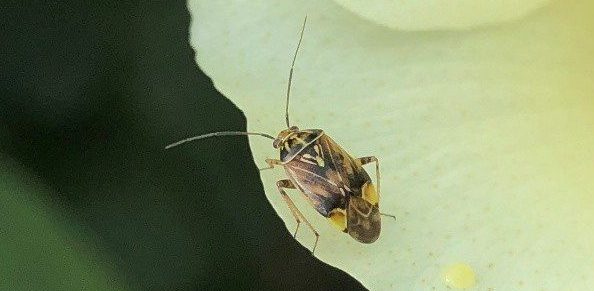
Figure 4. Adult tarnished plant bug.
In addition to thrips, ThryvOn also has activity on tarnished plant bugs (figure 4). Insecticide resistance and other changes in the landscape have increased plant bug pressure in some areas of the southeast. Like thrips, adult avoidance plays a role in the reduced plant bug populations and limited injury in ThryvOn cotton. In addition to feeding less, adult plant bugs likely deposit fewer eggs in ThryvOn. However, threshold populations and economic damage from tarnished plant bugs have been observed. As a result, growers must maintain scouting activities for plant bugs in ThryvOn cotton.
In prebloom cotton, treatment thresholds vary somewhat by geography. In Alabama, it is 8 adult plant bugs per 100 sweeps or maintaining 80 percent square retention. In North Carolina, it is 8 adult plant bugs per 100 sweeps and dropping below 80 percent square retention. Using an either/or approach is critical for plant bug management, particularly in areas with high plant bug pressure—and it may also be important in ThryvOn cotton. Although the threshold population of 8 bugs per 100 sweeps may not result in more than 20 percent pinhead square loss, adult plant bugs are also depositing eggs that will hatch into immatures over the following weeks. Proper scouting and insecticide timing can help reduce the populations of immature plant bugs observed in early-bloom cotton.
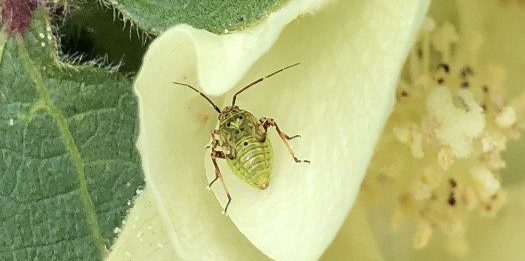
Figure 5. Immature tarnished plant bug.
As cotton moves into the bloom stage, immature plant bugs become the focus for scouting efforts (figure 5). Immature plant bugs prefer to feed on larger squares and are often hidden inside bracts, making adequate insecticide coverage challenging. One possible way that ThryvOn helps with plant bug management is by increasing the efficacy of insecticides. This could be due to a couple of factors. One factor is that immature plant bugs are thought to move more within the plant canopy of ThryvOn cotton as they are looking for better food sources. Unlike adults, however, they cannot move from the field to other hosts. This likely leads to immature plant bugs coming into more contact with residues of insecticides. Another factor that helps manage plant bugs is the delayed development of immature plant bugs. Immature plant bugs do not grow as quickly on ThryvOn Cotton. Much like humans, or any other animal, plant bugs feed more as they get larger. Because plant bugs appear to grow more slowly in ThryvOn cotton, less severe damage to squares, blooms, and bolls (figure 6) is observed, even if threshold populations of plant bugs are observed.
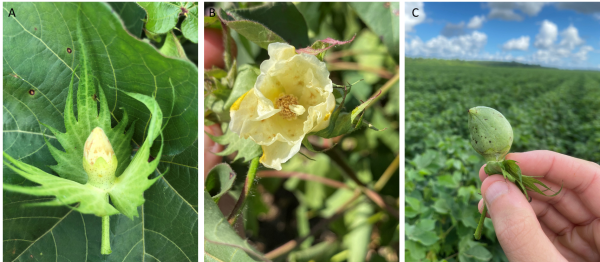
Figure 6. A dirty square (A), dirty bloom (B), and misshapen boll (C) from tarnished plant bug feeding.
The treatment threshold for immature plant bugs in blooming cotton is 3 per 5 row feet, sampled with a black drop cloth. Research done in the southeast indicates that this threshold can be used in both ThryvOn and non-ThryvOn cotton. One advantage of ThryvOn cotton is that populations tend to be lower or build more slowly than in non-ThryvOn cotton, often resulting in fewer insecticide applications. ThryvOn also provides more flexibility for within-season management. For example, when rainfall or challenging spraying conditions occur, growers will have a built-in “cushion” because the ThryvOn toxin is suppressing plant bug populations and feeding injury.
How to Utilize ThryvOn
Planting date can play a key role in timing plant bug infestations across the southeast. In some regions, plant bug infestations are heaviest in earlier-planted cotton. As adult plant bugs begin to disperse from weedy hosts to cotton in June, more mature fields are the most attractive because they have more food sources (squares). In other areas, plant bug infestations tend to be slightly higher in later-planted cotton. The reason for this is unknown, but it could be because populations increase throughout the season as other hosts are waning in suitability or because later-planted cotton is in a more suitable growth stage range for colonization. One way to maximize the impact of ThryvOn cotton for plant bugs in the southeast is to plant these varieties earliest in the regions where these planting dates have the highest likelihood of plant bug infestations. Another consideration is planting ThryvOn near corn because plant bug pressure is often higher on field borders next to corn. ThryvOn varieties could be positioned along these borders to create a buffer, reducing injury from dispersing plant bugs. However, large populations of plant bugs might still require supplemental control with insecticides in ThryvOn cotton. Another strategy would be to plant ThryvOn varieties away from corn or other sources of plant bugs, taking advantage of lower pressure from plant bugs and a reduced need for insecticide use. These decisions should be made on a farm-to-farm basis.
ThryvOn Take-Home Points
The impact of ThryvOn on the management of plant bugs may not always be as obvious as it is on thrips, but this new trait will have a purpose for cotton in the southeast. Some benefits, such as reduced crop injury and delayed population development, may be subtle. While this technology may not always eliminate or reduce the need for insecticide applications for plant bugs, there may be some benefits from increased insecticide performance and reduced crop injury. Integrating ThryvOn could also increase flexibility in the types of insecticides used and the sequence in which they are used. Proper scouting, monitoring, use of thresholds, and insecticide selection will still be critical for plant bug management in ThryvOn cotton.
ThryvOn Big Picture Takeaways
All ThryvOn varieties will also contain 3-gene Bt toxins for controlling caterpillar pests (e.g., Bollgard 3) and herbicide traits. However, the management of ThryvOn cotton will be different from other Bt cotton technologies. When the 2- and 3-Bt toxin varieties were released, insecticide applications for the target insects (bollworm and budworm) were greatly reduced or eliminated. While this may be true for thrips, it will not be for plant bugs in most situations. While plant bug populations are often smaller and delayed in development, treatment thresholds can be exceeded, and yield must be protected with insecticide applications based on economic thresholds.
To maximize the economics and insect management potential of ThryvOn cotton, each grower must determine which pest (thrips or plant bugs) is the more critical insect issue on his or her farm and consider planting dates and placement to maximize value. Additionally, proper scouting and monitoring for nontarget pests (spider mites, aphids, stink bugs, etc.) will still be critical. Applying thresholds and judicious use of insecticides will also be important for managing plant bugs.
References
- D’Ambrosio, D.A., G.G. Kennedy and A.S. Huseth. 2020. Feeding behavior of Frankliniella fusca on seedling cotton expressing Cry51Aa2.834_16 Bt toxin. Pest Manag. Sci. 76: 2781-2786.
- Graham, S.H., R. Smith and A. Jacobson. Cotton insect, disease, nematode and weed recommendations for 2023: insect control. IPM-0415. Alabama Cooperative Extension Service. Auburn University, Auburn, Alabama.
- Graham, S.H. and S.D. Stewart. 2018. Field study investigating Cry51Aa2.834_16 in cotton for control of thrips (Thysanoptera: Thripidae) and tarnished plant bugs (Hemiptera: Miridae). J. Econ. Entomol. 111: 2717-2726.
- Graham, S.H., F.M. Musser, A.L. Jacobson, A. Chitturi, B. Catchot and S.D. Stewart. 2019. Behavioral responses of thrips (Thysanoptera: Thripidae) and tarnished plant bug (Hemiptera: Miridae) to a new Bt toxin, Cry51Aa2.834_16 in cotton. J. Econ. Entomol. 112: 1695-1704.
- Huseth, A.S., D.A. Ambrosio, B.T. Yorke, G.P. Head and G.G. Kennedy. 2020. Novel mechanism of thrips suppression by Cry51Aa2.834_16 Bt toxin expressed in cotton. Pest Manag. Sci. 76: 1492-1499.
- Reisig, D.D. and A.S. Huseth. 2023 North Carolina Agricultural Chemicals Manual: insect control on cotton. North Carolina Cooperative Extension. North Carolina State University. Raleigh, NC.
 Scott H. Graham, Extension Specialist, Assistant Professor, Entomology and Plant Pathology, Auburn University; Dominic Reisig, Extension Entomologist, Professor, North Carolina State University; Anders Huseth, Extension Entomologist, Assistant Professor, North Carolina State University; Jeremy Greene, Extension Entomologist, Professor, Clemson University; and Phillip Roberts, Extension Entomologist, Professor, University of Georgia
Scott H. Graham, Extension Specialist, Assistant Professor, Entomology and Plant Pathology, Auburn University; Dominic Reisig, Extension Entomologist, Professor, North Carolina State University; Anders Huseth, Extension Entomologist, Assistant Professor, North Carolina State University; Jeremy Greene, Extension Entomologist, Professor, Clemson University; and Phillip Roberts, Extension Entomologist, Professor, University of Georgia
New March 2023, Maximizing Insect Control in ThryvOn Cotton in the Southeast, ANR-2984


